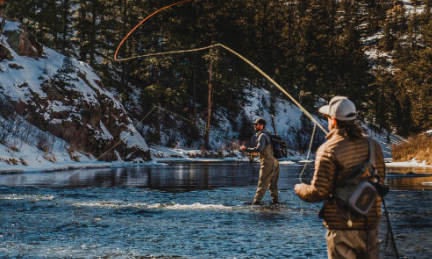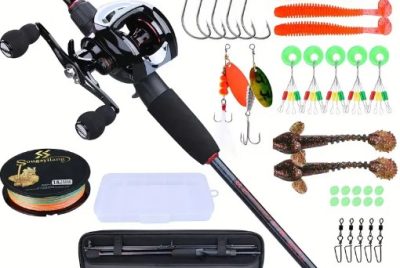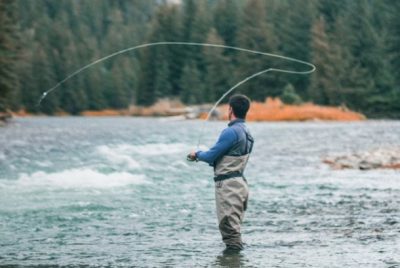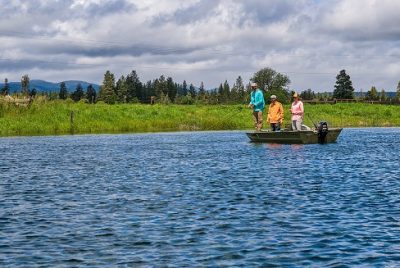Winter Fly Fishing
Introduction
Winter fly fishing is a hidden gem in the world of angling. Join me in exploring this chilly yet rewarding pursuit. As an avid enthusiast and advisor, I’m here to share insights and suggestions to make your winter fly fishing adventures successful and enjoyable.
Selecting the Right Gear and Clothing
When it comes to winter fly fishing, the right gear and clothing can make all the difference. Let’s delve into the essentials that will keep you comfortable and productive on the water, even in the coldest of seasons.
Choosing the Ideal Fly Rod and Reel
Your choice of equipment is crucial during the winter months. While your go-to fly rod and reel might serve you well in other seasons, winter requires a specific setup. We’ll explore why a well-matched fly rod and reel are essential for success when the mercury drops.
Winter fly fishing calls for precision, so a fly rod with a slow to moderate action is preferred. The slower action allows for delicate presentations, and it’s more forgiving when casting, especially in cold weather when your casting stroke may not be as fluid. Pair this with a reel that has a smooth drag system and sufficient backing capacity.
Dressing for Cold Weather
Preparation for winter fly fishing begins with dressing for the cold. It’s no secret that staying warm in frigid conditions can be a challenge, but the right clothing can make all the difference. Layering is key.
Start with a moisture-wicking base layer to keep sweat away from your body. Over this, add an insulating layer to trap warmth. Fleece or down materials work well for this purpose. Your outer layer should be both windproof and waterproof to shield you from the elements. Don’t forget about your extremities; insulated gloves and waterproof boots are essential.
A good hat and a neck gaiter or buff will help protect your head and face from the biting cold. And never underestimate the importance of warm socks. When it comes to winter fly fishing, every part of your body should be prepared for the chill.
Picking the Perfect Winter Fishing Spots
Finding the right location is key. Explore the factors that can guide you to the ideal winter fishing spots.
Understanding Seasonal Behaviour
Understanding the behaviour of fish during the winter is crucial. As the water temperature drops, fish become less active, and their metabolism slows. They tend to move to deeper and slower-moving waters. This shift in behavior is important to keep in mind when selecting your fishing location.
Trout, for example, may seek out slower stretches of river or deep pools. In contrast, some species like pike and walleye might remain active, even in the chillier waters. A bit of research or local knowledge can provide valuable insights into the seasonal behaviour of fish in your area.
Finding Slow-Moving Waters
Winter fly fishing success often hinges on finding slow-moving waters. These areas offer some key advantages. First, the slower current means fish expend less energy to hold their positions. Second, it’s easier for you to present your flies at the right depth and speed. But how do you find these spots?
Begin by exploring the tailwaters of dams or reservoirs. These areas tend to have more stable water temperatures, which attract fish. Likewise, slow-moving stretches of rivers and ponds can be productive in winter. Pay attention to back-eddies, slow corners, and deep holes. These are often the favourite haunts of cold-water fish.
Fly Selection for Winter Fishing
Selecting the right flies for winter conditions can be challenging. Get insights into the types of flies that work best when the water is cold.
Winter fly fishing demands a more subtle approach. Fish are less active, so it’s important to choose flies that are enticing but not overly aggressive. Nymphs and midge patterns are often effective choices. They mimic the smaller aquatic insects that are present year-round. Sizes 18 to 22 are common for midges, and you’ll want to have a selection of colours in your fly box.
Woolly buggers, both weighted and unweighted, are another versatile choice for winter fishing. Their lifelike movement can trigger strikes from fish that may not be willing to chase faster-moving prey.
Dry flies can also work, especially during midge hatches, when fish rise to the surface. The key is to focus on smaller and more subtle patterns.
Experiment with different flies and pay close attention to what the fish are feeding on. Don’t be afraid to change your fly selection until you find what’s working on that particular day.
Effective Winter Fly Fishing Techniques
Mastering the right techniques is essential for a successful winter fly fishing experience. Discover two effective methods for winter angling.
Nymphing in Cold Water
Nymphing, which involves drifting subsurface imitations of aquatic insects, is a go-to technique for winter fly fishing. Fish are often holding in slower water during the winter, making nymphing highly effective. The key is to get your nymphs down to the fish’s level.
Consider using a strike indicator to detect subtle takes, as fish are less aggressive in their feeding behavior in cold water. Be patient and make precise casts. Small adjustments in your nymphing rig can make all the difference in getting those wary winter fish to bite.
Dead Drifting Dry Flies
Surprisingly, dry fly fishing can also be productive in the winter, especially during midge hatches. When fish are rising to feed on the surface, the thrill of watching a fish sip your dry fly can be particularly satisfying.
The key to success is presenting the dry fly so it drifts naturally in the current. Use a high-floating dry fly and focus on dead drifting – letting it float drag-free along the surface. Keep a close eye on your fly for any subtle takes, as fish may not be as exuberant in their rises during the winter.
The Thrill of Winter Fly Fishing
Winter fly fishing is not just about catching fish; it’s an experience. The solitude, the serenity, and the crispness of the winter air add an extra layer of enjoyment to your angling adventures. While the catch might be slower and more challenging, the satisfaction of landing a fish during the colder months is deeply rewarding.
My Personal Winter Fly Fishing Experience
I’ll share some personal experiences, including memorable catches in cold waters and the unique beauty of the winter outdoors.
Unforgettable Cold-Water Catches
Winter fly fishing has delivered some of my most unforgettable catches. There’s a sense of accomplishment in successfully hooking and landing a fish when the conditions are less than ideal. The challenge makes every catch more meaningful.
One particularly memorable day was on a quiet winter river. The world was hushed by snowfall, and my breath hung in the cold air. After several hours of patience, a brown trout gently rose to my perfectly presented dry fly. The battle was slow and deliberate, but the satisfaction was immeasurable.
The Beauty of the Winter Outdoors
Beyond the catches, the beauty of the winter outdoors during a fly fishing expedition is incomparable. Snow-dusted landscapes, the silence of nature, and the glint of sunlight on icy waters create a unique canvas for your adventures.
I remember one early morning when I was greeted by the soft pink and orange hues of a winter sunrise while standing in the middle of a frozen river. The world seemed to stand still, and for a moment, I was the only living soul in that serene landscape.
Conclusion
In conclusion, winter fly fishing offers a unique and rewarding experience for anglers. By choosing the right gear, understanding seasonal behaviour, and employing effective techniques, you can embrace the challenge and beauty of winter fishing. The chill in the air is a small price to pay for the unique satisfaction and tranquility that winter fly fishing offers.
FAQs
- Is it safe to fly fish in the winter?
- Winter fly fishing is safe when you take precautions and dress appropriately for the cold. Always prioritize safety.
- What kind of flies are best for winter fly fishing?
- Smaller nymphs and midge patterns are often effective in cold water conditions. Woolly buggers are versatile and can also produce results.
- Do fish bite during the winter?
- Yes, fish are active during the winter, although they may be more selective in their feeding patterns. Patience and the right techniques are key.
- What is the biggest challenge of winter fly fishing?
- The biggest challenge is staying warm and comfortable in cold weather. Proper clothing is essential. Additionally, fish are less active, so a more delicate presentation and the right fly choice are necessary for success.
- Why should I try winter fly fishing?
- Winter fly fishing provides a unique and less crowded experience, and catching fish in challenging conditions is incredibly rewarding. It’s also an opportunity to enjoy the serene beauty of winter in the great outdoors.




